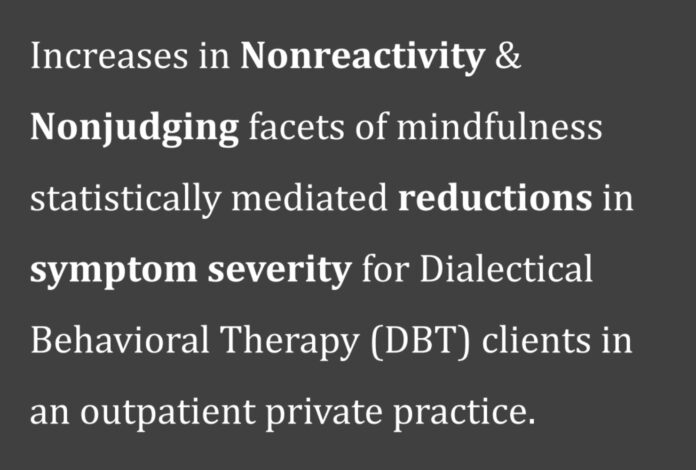Background
• Mindfulness-based treatments for various psychopathologies are clinically effective and growing in prevalence of use, i.e. Dialectical Behavioral Therapy (DBT) [1,2]. Mindfulness in DBT has been broken into five facets [3]
•Describing, Observing, Acting With Awareness, Nonreactivity, Nonjudging
•Specific mechanisms of change in mindfulness-based treatments are still poorly understood [5]
Current Study & Methods
Research Question: Do the five facets of mindfulness mediateTreatment outcomes in DBT?
• Hypotheses: acting with awareness and nonjudging facets will mediate changes in depression, anxiety, borderline symptoms, emotional dysregulation, and rumination [4]
– Specifically, increases in mindfulness –> decreases in symptomology
Participants
• N= 62 adult DBT patients at an outpatient private practice and training institute in Southern California
•Average age = 30.1 years old; 69% female; 46.8% declined to state,45.2% White, 1.6% Black, 1.6%, Latino/a, 4.8% “Other”; 45.2% with confirmed BPD diagnosis
Measures
• Measures were administered at intake and one additional time point after a minimum 2 months of treatment; average time between measures = 7 months. *Not all participants completed treatment*

Analyses
Within-subjects mediation analysis with percentile bootstrapping was performed using the MEMORE macro for SPSS [11] to assess significance of the indirect effects of the intervention, DBT (X) on outcomes (Y), through each of the five facets of mindfulness (M)
•Missing data (14.9%) handled using maximum likelihood imputation

Results
There were significant indirect effects of DBT on ALL outcomes through FFMQ total

• Hypotheses partially supported
• The below FFMQ facets mediated the effect of DBT on select outcomes
• Acting with awareness –> depression
• Nonjudging –> anxiety, borderline symptoms, rumination, emotion dysregulation
• Nonreacting –> depression, anxiety, borderline symptoms, rumination



Discussion
• Nonreactivity and Nonjudging appear to be important mechanisms of change for various outcomes in DBT
• From intake to second measurement, a one unit increase in FFMQ nonreacting score predicts score decreases of nearly 9 units in borderline symptoms (BSL-23), ~2 units in depression (PHQ-9) and anxiety (GAD-7), and 3 units in rumination (RRS)
• A one unit increase in FFMQ nonjudging score predicts score decreases of 5 units in borderline symptoms (BSL-23), 1 unit in anxiety (GAD-7), 3 units in rumination (RRS), and 5 units in emotion regulation (DERS)
• Nonjudging uniquely related to emotion dysregulation; not depression. Acting with Awareness only mediated the effect on depression. No significant effects for Observing and Describing
•The naturalistic setting supports generalization of experimental findings on treatment mechanisms to real-world practice
•Limitations include the quasi-experimental design; low power due tosmall sample size; “mediation” is not meant to imply true causality
•The use of a novel statistical tool (MEMORE) may serve to promote future use of robust methods in this and related research areas
Research conducted by: Robert M. Montgomery, B.F.A., Hollie Granato, Ph.D., Aly DiRocco, M.A., Marget Thomas, Psy.D., Keren Shemesh, M.A., Max Stivers, B.A., Kate Cohen, B.A., Sandra Chen, B.A., Lindsey Thornburg, B.A., and Lynn McFarr, Ph.D.
References
[1] Goldberg, S. B., Tucker, R. P., Greene, P. A., Davidson, R. J.,Wampold, B. E., Kearney, D. J., & Simpson, T. L. (2018). Mindfulness-based interventions for psychiatric disorders: A systematic review and meta-analysis. Clinical Psychology Review, 59 (August 2017), 52–60.
[2] Linehan M. M. Cognitive-Behavioral Treatment for Borderline Personality Disorder. New York: Guilford Press; 1993
[3] Baer, R. A., Smith, G. T., Lykins, E., Button, D.,Krietemeyer, J., Sauer, S., … Williams, J. M. G. (2008). Construct validity of the five facet mindfulness questionnaire in meditating and nonmeditating samples. Assessment,15(3), 329–342.
[4] Mitchell, R., Sullivan, T., & Roberts, R. (2018). Changes in mindfulness facets in a dialecticalbehaviourtherapy skills training group program forborderline personality disorder, (August).[
[5] Alsubaie, M., Abbott, R., Dunn, B., Dickens, C.,Keil, T. F., Henley, W., & Kuyken, W. (2017). Mechanisms of action in mindfulness-based cognitive therapy (MBCT) and mindfulness-based stress reduction (MBSR) in people with physical and/or psychological conditions: A systematic review. Clinical Psychology Review, 55 (April), 74–91.
[6] Kroenke, K., Spitzer, R. L., & Williams, J. B. (2001). The PHQ-9: validity of a brief depression severity measure. Journal of general internal medicine,16 (9), 606–613.
[7] Spitzer RL, Kroenke K, Williams JBW, Lowe B. A brief measure for assessing generalized anxiety disorder. ArchInernMed. 2006; 166:1092-1097.
[8] Bohus, M., Kleindienst, N.,Limberger, M. F., Stieglitz, R. D.,Domsalla, M., Chapman, A. L., … Wolf, M. (2009). The short version of the BorderlineSymptom List (BSL-23): Development and initial data on psychometric properties. Psychopathology, 42(1), 32–39.
[9] Gratz, K. L. & Roemer, L. (2004). Multidimensional assessment of emotion regulation and dysregulation: Development, factor structure, and initial validation of the Difficulties in Emotion Regulation Scale. Journal of Psychopathology and Behavioral Assessment, 26,41-54.
[10] Treynor, W., Gonzalez, R., & Nolen-Hoeksema, S. (2003).Rumination reconsidered: A psychometric analysis.Cognitive Therapy and Research, 27.
[11] Montoya, A. K., & Hayes, A. F. (2017). Two-condition within-participant statistical mediation analysis: A path-analytic framework. Psychological Methods, 22(1), 6–27.





